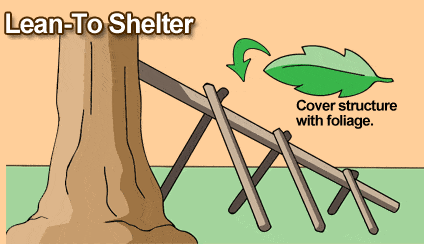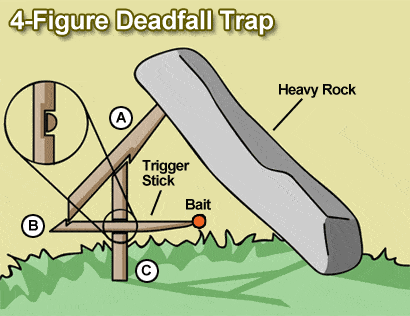Surviving in the extreme cold in 2023 requires a cold head, clear measures taking, and background knowledge. Having a proper set of survival gear, of course, can multiply your chances for survival. However, it can still be challenging to stay alive in the wilderness, let alone in the extremely cold weather conditions. In this article, we would like to discuss the essential guidelines on cold weather survival, including staying warm, hydrated, safe from animals, instructions to building a shelter, and other important skills that will increase your chances of cold weather survival and help you save your body from freezing.
Surviving in the extreme cold is mostly about saving heat and keeping your body temperature up: hypothermia can be deadly. The traditional survival techniques do not always apply due to cold and wet surroundings. By following the techniques in this guide, you will greatly improve your chances of survival. There is always something you can turn into account.
Disclaimer: The survival tips and hacks on this website are for informational purposes only. The authors take no responsibility for the reader’s individual actions or usage of the information presented on this page.
Be Prepared

Cold Weather Survival Clothes
To minimize hypothermia risks, every person would certainly need these to survive in the extreme cold weather. Ensure your four-layer dress is put on:
- Underwear long enough to cover and keep from wetting your skin.
- Make sure your trousers, shirts, and sweaters fit you perfectly.
- Get as warm as you can with a parka or a warm undercoat.
- Use windshields to increase your cold-protection manifold.
- Get ice cleats for your foot!
- Zippo hand warmers to protect your hands!
Take care to cover your feet thoroughly: thick woolen socks are what you need. If you happen to have a pair of solid tactical boots on you, your chances go up manifold! Winter footwear that can sustain cold temperatures. Your hands should be protected as well: take mittens or gloves made from natural materials like wool and leather.
Survival Kits
Being totally prepared to survive in the extreme cold weather is unthinkable without basic items, you should take care to purchase and take them with you on the trip. Here is the list:
- A lot of water, no less than fifteen gallons per capita. Think about the canned Alka Power, for instance. They are totally worth it.
- Easy-to-cook food is essential:
- Clothes to keep warm
- Drugs and antibiotics you know you need
- If you travel by car, don’t forget extra gas, chains for tires.
- A survival shovel, like this EVATAC Tactical one
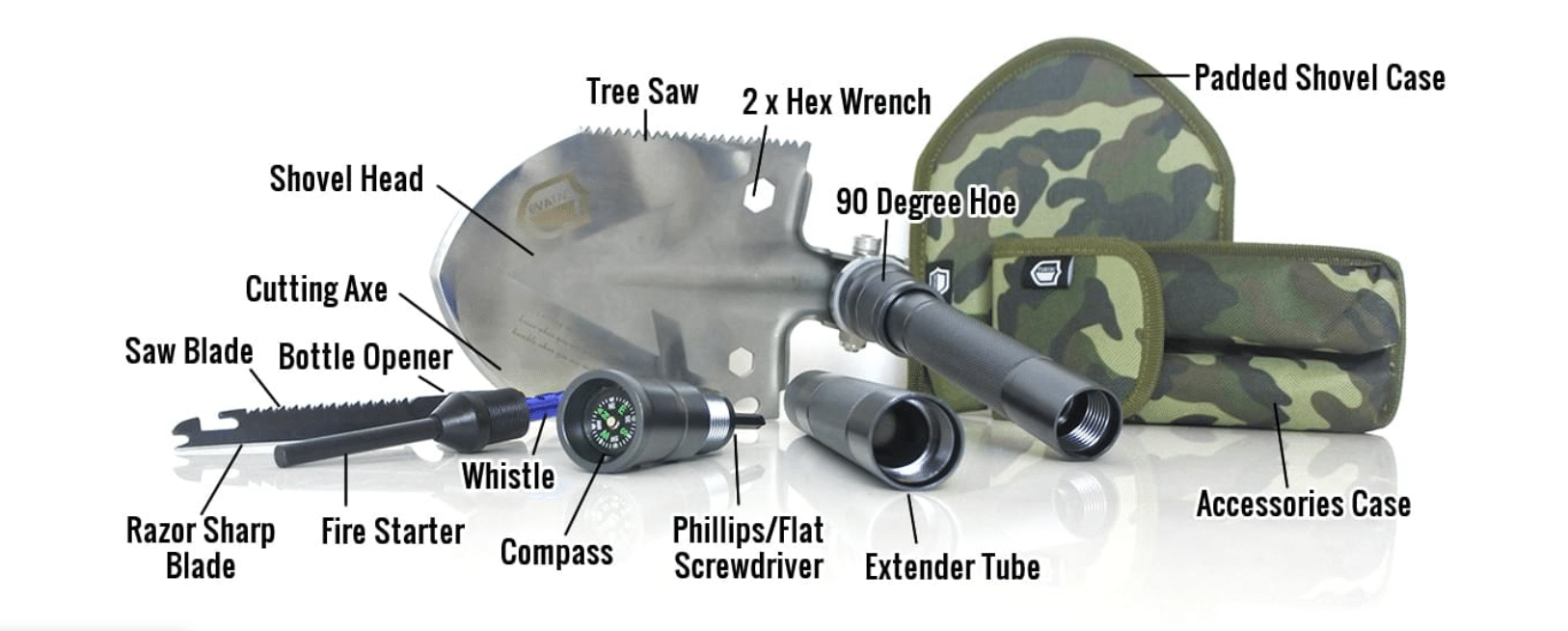
- Deicing salt or sand
- A handy tactical knife. I’d go for the ESSEE carbon Model 4 for any kind of situation.
- A solid survival ax
- Firestarters
- Survival Matches
- Torch
- Survival guns to protect from predators and hunt
- A watch and compass
- Glasses
- A tent for cold weather
And more! Don’t overwhelm yourself with too many items, but consider taking those that will save your life in the extreme cold-weather environment.
1. STOP and Think
Once you got lost to survive in cold weather situation, you should remain calm and be practical, plan out, and make no bad decisions. Use the Boy Scouts mnemonic device of “STOP,” which stands for “Stop, Think, Observe, and Plan.” Try to move to accelerate your blood and avoid hypothermia.
You’ve just discovered that you are lost in the snow or an extremely cold climate. You’re unsure about whether or not rescue will be arriving. Here is a list of what you should be doing:
- Keep warm and avoid hypothermia.
- Find or build a shelter before nightfall.
- Use snow as a source of drinking water.
- Create a fire to minimize hypothermia and take to some survival cooking.
- Wait at least one week for rescue.
- Find a source of food.
- Fashion a weapon you can use for self-defense.
- Travel in one direction during daylight. Sleep at night.
2. Don’t Panic
Panic is never an option if survival is concerned, especially in cold weather conditions. All your survival skills will be in vain if you don’t come to your normal senses. Stay focused and consider the ways you have to survive. Anxiety and stress bring discomfort and interfere with clear thinking. Avoid panic attacks at all costs: use positive thinking and don’t blame yourself or anybody. Mental instability, as a result of cold, can lead to terrible consequences.
Do not waste your energy and try to get yourself out by remembering and applying survival skills, you know. This article will help you refresh your memory on the subject and help you survive in the extreme cold weather. Read on!
3. Consider Dangers
- Hypothermia. Heat is of crucial importance, so protect your body from unfortunate contacts with dampness, winds, colds, and cold water.
- Finding or building a shelter is a way to go. Your clothes will help you stay warm for a while, but you should take immediate actions to keep warm as long as you can.
- A moisture-wicking base layer will help you keep sweating off your body. All your skin must be closed to avoid direct contact with the cold environment.
- Be ready to face wild animals and avoid close encounters with blood-thirsty predators.
Continue reading to find out what else you should do to ensure your safety in extreme cold weather environments.
4. Keep Warm
Keeping your body warm is essential in extremely cold weather situations. Take care that you know techniques of maintaining the warmth and be aware of the possible dangers a cold weather situation can entail.
Avoid Hypothermia
Hypothermia can kill any person faster than any other threat in an extremely cold climate, so staying warm and keeping your body temperature up should be priority number one. First, your skin cools down, then your entire body.
- If you have extra clothes, then wear enough layers to stay warm while still being able to move around comfortably.
- Make sure that your clothing stays as dry as possible. Be sure to wear multiple layers of socks.
- Throughout these entire survival steps, you are always going to want to stay as dry as possible.
- You’ll also want to create a fire each night to keep your body temperature up.
- Use the fire’s heat to dry any clothing that you might have gotten wet during the day.
To avoid hypothermia, the most crucial thing to focus on in a cold-weather environment is using your heat as practically as possible. Multi-layered clothing is a great way to keep your human body safe from heat loss and accelerate your own heat production. Insulation is another must-have to ensure your safety in winter conditions. Use these tips not to join the toll of hypothermia victims.
How to Prevent Frostbite?
Apart from hypothermia, there are several other dangers of walking for too long in the cold air. Frostbite concerns the external cells of your organism. Frostbite is when parts of your skin are injured by freezing as ice builds up around the cells and leads to the tissues’ death and possible amputation.
Those parts of your body that are far from the heart are more likely to get frostbite: nose, ears, fingers, and toes. In cold weather situation, your blood vessels are constricted because the organism is trying to keep internal organs warm. So, distant parts get less warm blood flow. You should maintain your internal heat to combat external cold temperatures. Frostbite can attack you after 30 minutes of being in a cold-weather situation.
Here are the symptoms:
- core temperature drops
- numb body parts
- a needly feeling
- the skin gets hard
- blood-red spots on your skin
- unhealthy color
- pains
- painful blisters
Numb fingers are a direct sign that you are freezing; take measures to get warm asap unless you want parts of your body amputated.
Here is what you should do to treat frostbite:
- Avoid temporary unfreezing
- Put off wet clothes
- Hold the frostbitten area up.
- Use warm water to unfreeze
- Wrap the area into a cloth
- Avoid moving your injured part.
- Do not rub it to avoid damage to tissues.
How to Treat Frostnip?
A light skin injury caused by cold temperature usually occurring in your nose and fingertips. Rub the area with snow to make it warm again and prevent severe frostbite. Move your fingers under the cover of your mittens of gloves to bring back warmth. Don’t let ice crystals form on your skin.
How to treat Chilblain?
The cold temperature of the air causes chilblain. It characterizes by red spots appearing on your skin. If unattended to, the light skin injury transmutes into swells and pains. Make some movements to accelerate the blood circulation and, if possible, rub some warming balm into your skin.
How to Treat a Trench Foot?
If your feet are exposed to the wet and cold for a long time, you can experience this injury. Your feet’s skin and flesh will cramp, itch, or ache. They can also get very numb, which, if untreated, can lead to amputation. Keep your feet dry at all costs, and replace your socks as often as possible. Rub your feet to boost blood circulation.
Avoid Hypoglycemia
When you are cold and put in a cold-weather survival situation, your energy is wasted at a higher rate. Our bodies convert energy into warmth if we are exposed to cold temperatures for a substantial period. We start making uncontrollable shivering to create some useful heat, uncontrolled. Fat is transformed into energy faster when the weather is cold, and the level of sugar in the blood drops significantly, which entails hypoglycemia. It can interfere with your clear thinking and making decisions, barring your way to survival in a cold-weather situation.
You should consume enough simple sugars or snacks, like chocolate, fruits, and vegetables. You are lucky if you have them with you. If not, bank on a fast rescue.
5. Make a Fire
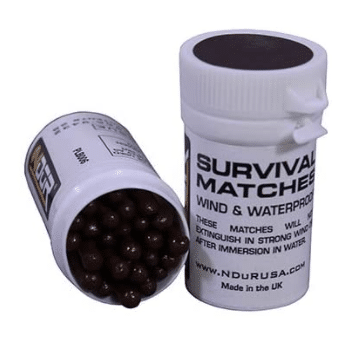
To successfully start a fire for cold weather survival, you need to be aware of several factors. Read on and find out what is different about fire-starting in the cold weather. Think about containing the flame in a limited area to ensure the fire’s efficiency.
Build a fire near a rock: it will get the heat from the flame and provide extra warmth. Or you can surround the fire with stones to let them heat up and radiate more warmth. Use the flame to dry your clothing and cook food. Place the fire into your shelter to keep it warm.
Make the fire at some level above the ground to avoid melting of the surrounding snow. Make sure the fuel for the fire is dry. It can be challenging to search for fuel in extremely cold conditions: pick pine sticks, dry bark, and small pieces of tinder to ignite the fire faster.
The rubbing technique will not be helpful for cold weather survival. Surely, it can accelerate your blood flow as you rub the sticks against each other, but a firestarter will be of much use.
The wind is another barring factor while igniting the fire in the cold weather, so it will take more time to raise the fuel’s temperature from the freezing point up.
Surprisingly, ice can be used to ignite the fire while having a smooth and curved surface. Use it as a magnifying glass to concentrate the sunrays on the fuel.
Building a fire in the snow can be difficult because most of the materials will be too wet to ignite. You will need to find a relatively dry area as a location to construct your fire. Keep your core body temperature normal to avoid cold injury and continue your survival pursuit. Avoid carbon monoxide poisoning by ventilating your space where the fire is.
Building The Structure
Step 1: Gather any dry tinder, twigs, and branches of various sizes that you can find.
Step 2: Using the smaller twigs, create a teepee shape with a tinder placed in the center.
Lighting The Fire
If you have a survival lighter or anything that sparks, use it to ignite the tinder.
If you have glasses, binoculars, or a camera, use the lens to concentrate the sun’s rays on the tinder to ignite it. Then blow when it starts smoking.
You can use the fire-plow method, but again, the materials must be completely dry and not saturated for this to work:
The Fire-Plow Method
Step 1: Find a softwood and cut a groove in its base.
Step 2: Place some tinder at one end that you will ignite.
Step 3: Using a hard stick, plow the end up and down this groove to create friction.
Step 4: The tinder will begin to smolder. Blow on it to help fuel the fire catching process.
Step 5: When the fire catches, place more tinder and small twigs on the fire to help it grow.
6. Build a Shelter
If you are able to find a nearby cave, this is a great shelter to use in extremely cold environments. However, be sure that the caves are not already occupied by animals, such as bears, before entering them.
If you are unable to find a cave, there are two other effective shelter systems that you can use in the extremely cold climate.
The Snow Cave
Step 1: Dig a hole into the snow.
Step 2: Discard any snow downhill.
Step 3: Dig upward to create the sleeping area above the door.
Step 4: Use a stick to create ventilation holes in the roof to avoid carbon monoxide poisoning when making a fire.
Step 5: Create a packed snow door to cover the entrance.
Step 6: Make sure there are ventilation holes in the door.
If you are in forest areas, then create a “Lean-To Shelter”:
Creating a “Lean-To” shelter:
Step 1: Find a large branch and lean one end up onto a tree.
Step 2: Place smaller branches at 45-degree angles along the length of the large branch.
Step 3: Cover the entire structure with leaves and foliage as an insulation layer.
7. Find a Shelter
Natural Shelters
It is highly recommended that you should avoid being out in the cold for a l
ong time. In the cold weather, your body spends tons of energy to maintain warmth. You should find shelter as fast as you can. Instead of building the shelter, you can search for them here:
- Caves. They need modification of your part: bring rocks and branches to close the cave’s mouth from winds and snowfall.
- Hollow tree logs. They need to be cleaned and bolstered by tarps or any other material to keep warmth inside.
- Big pines’ heavy branches can be a good place to hide from winds and wait for help.
Natural shelters can be a risky choice. Check them for animals or any other dangers.
Man-made Shelters
It will be your lucky day if you run into a human-made shelter while struggling
for your life in cold conditions. It will stop your heat loss immediately, minimize the risk of a frostnip, and save you from freezing to death. Check whether anybody is still in there, check for wild animals, and instability.
8. Keep Hydrated
The first thing you should be aware of is that eating snow by itself does not hydrate the body. First off, melt snow.
Melting Snow By Fire:
If you have a tin/aluminum can available, this will provide a perfect container to add the snow and melt over a fire.
Melting Snow By Sunlight:
If you in an environment where you are unable to create a fire, then your best option is to get any waterproof material, set a thin layer of snow over it.
The more reflective the surface, the better. Allow the sun to melt the snow, and the drips can be funneled into a container.
To speed up the melting process, use a lens from glasses, a camera, or binoculars to focus the sun’s rays onto the snow.
You can easily fall forgetful of the need to drink while exposed to cold and wind in Antar
ctica, for example. Keeping hydrated is essential to sustain your life powers and continue fighting for your life. Make pauses in your activities to have a water drink: it will stabilize the blood flow and help you retain warmth. You can be safe from freezing if you drink warm water. Remember, wherever you are, in the Sahara or Antarctica, water is a must.
9. Finding Food
The animals in the forest provide a valuable source of nourishment.
Unless you are an expert hunter, you will have a better chance of trapping your food rather than trying to catch it.
Use the 4-figure deadfall trap as a way to trap and kill your food.
The 4-Figure Deadfall Trap:
Step 1: Gather 3 branches and a heavy stone.
Step 2: Cut notches in the branches, as indicated in the illustration below.
Step 3: Hold up the rock with one hand while positioning sticks “A” and “C.”
Step 4: Once the weight of the rock is resting on “A” and “C,” use your free hand to insert and mount the trigger stick “B.”
Step 5: Let go, and the trap should be balanced and set.
Step 6: When a bird or animal comes along to eat the bait, the trigger stick will trip, and the rock will kill with a fatal blow.
10. Traveling/Resting:
Follow the Schedule
Be careful with your timing: in winter, it gets dark and cold very quickly, so consult with your watch as you do anything. Try to complete all essential survival tasks when the Sun is up. Do not forget about regular nutrition, and be as active as possible to normalize the blood flow and avoid frostbite or anything worse. Survival in cold temperatures requires accuracy and punctuality no less than other survival skills. Having a watch will be a beneficial advantage in any extreme situation.
Travel During the Day
Always travel during the day while resting at night. The snow will be the biggest obstacle in making distance while traveling. So the good idea is to fashion snowshoes out of the available twigs that you have at your disposal.
Creating Snow Shoes
Step 1: Find two flexible branches.
Step 2: Bend them into a round, pear shape.
Step 3: Tie the ends together with a cord or torn strips of clothing.
Step 4: Cross smaller branches over the pear shapes.
Step 5: Interweave the cord/strips to secure the smaller branches to the snowshoe.
Step 6: Find a flexible branch to act as a strap to slide your own shoe into.
Step 7: Secure this branch to the sides of the snowshoe.
Step 8: Slide your foot into the strap, and you’re ready to start walking in the snow.
Once you have created your custom winter boots, follow the same techniques you would use in a forest survival scenario. Find a nearby stream and follow it downstream until you reach any signs of a settlement or civilization.
Walk Safely
Walk slowly and carefully. You can utilize a long stick to prod the path in front of you. Avoid post-holing by checking the path as you go.
It can be challenging to keep a normal pace walking in the snow; it entails severe dehydration, sweating, and tiredness.
Tree wells should be avoided: while they may look secure, you can get buried under thick layers of snow.
If you have fallen into a hole, try keeping your head over the snow level, stay cool and collected, breathe normally, and try to dig your way out using your hands. DO it carefully to avoid being further buried in the deep snow.
Walking On Ice
If you can avoid it, do not walk on ice. Safe ice walking requires specific equipment you are unli
kely to have with you in most cases.
However, if you have to, here are some tips:
- Walk carefully and with small steps in a penguin-like manner.
- Hold out your arms to keep balance and catch the ice once you have fallen through
- Arm yourself with a long stick to check the path in front of you
- Avoid nearing cracks
- Choose thick ice to walk on
- Walk on smooth ice
- If the temperature is six degrees Celcius below zero, do not attempt walking on ice.
Once You have Fallen Through
Get out of the cold water as fast as you can. Flatten against the surface of the ice as you have climbed out of the pool and roll away to keep yourself warm. The faster your actions are, the higher are the chances of survival. Otherwise, your body will lose heat dramatically, the blood flow will drop, and you will start freezing quickly.
In the Water
- Do not panic or waste your energy: movements accelerate your heat loss. It is shocking to be in cold water, especially if the air temperature is no warmer, but the skill can be nurtured.
- Take a fetus-like position to keep your organism from fatal heat loss.
- The key is to get out of the water as quickly as you can
- Keep clothes
- No swimming if you are unsure you can make it to the shore
- If you are not alone, keep as close to each other as possible to keep warm.
Out of Water
The next problem you face once you are out of the cold water is getting warm and stop shivering. Your hands and legs will fail to obey, but you will be safe if you take action immediately. The key is collectedness and your focus on survival.
Dry your wet clothing using your body heat or fire and put on the dry ones. DOn’t let
- Use fire to accelerate the process.
- If you don’t have a fire, keep the wet clothing on and bank on your body heat.
- Look for shelter to get away from the wind and get warm.
- Make a snow shelter to protect your body from wind.
- Wrap your wet-clothed body with a piece of cloth to produce more body heat
11. If Your Car is Stuck in Snow
If you travel by car and get stuck, here are the things to consider:
- Try to get it unstuck, but don’t spin tires in vain: keep turning your wheels or switch from forward to reverse and backward.
- Clear the tires from snow: the shovel will help mighty.
- Deflate the tires a bit.
- Use floor mats or tree logs to provide extra traction.
- Switch between gears and give some more gas at times until the tires catch
- Hope for passers-by to get your car unstuck
Having a survival kit in your car is the best option. Read the article further to find out what you should do if you fail to unstuck the car.
How to Shelter in a Car
Heat, liquids, food, and a chance of survival are the things to focus on while you are struggling for life in the cold weather. When you are by your properly-equipped bug-out vehicle, it’s one thing. But if you get lost in a regular car, here are the tips to follow:
- Stay put. Go away only if you know where and why
- Keep your body warm
- Wrap your body in many layers of clothes to be able to face any weather
- Insulate your car and yourself using items at your disposal. Do not leave any places of exposed skin.
- Start your car for a couple of minutes per hour to keep your body warm.
- Turn on the radio to be aware of the weather changes.
- Your feet should be kept off the floor.
- Do not forget to switch off the engine.
- Ventilate your car
- Make the car noticeable from a distance by attaching any bright-colored clothes or sticking flashlights, and use flares if you have them to attract the attention of people near your area.
- Keep your smartphone close to your body to keep its battery safe.
12. Beware of Predators


Bears:
Bears are hibernating during the winter months, and you will not likely run across any unless you disturb their sleeping quarters. Be careful when traveling, and be cautious of caves. It’s possible that hibernating bears already occupy them, and you would not want to disturb them.
Wolves:
Wolves will only attack when they feel that they are being threatened. Keep your distance and try
not to appear threatening.
13. Watch Out for Storms
Being focused on heat is the ultimate activity during your survival in cold air. You should decide on staying in a shelter or moving on in search of help. However, things can get more challenging while you have to face a storm: your vision will be reduced, the heavy wind will interfere with your walking, landmarks will get harder identified, trails will be covered up with layers of snow.
However, if you have to go on, here are the things to consider:
- Travel in the daytime
- Remember about eye protection.
- Avoid frostnip by maintaining body heat.
- Walk carefully
- Drink often (drink something warm to accelerate the blood circulation)
- Retrace your steps and try going back
- Notice tracks on the snow to orient
14. Sleeping in Cold Weather
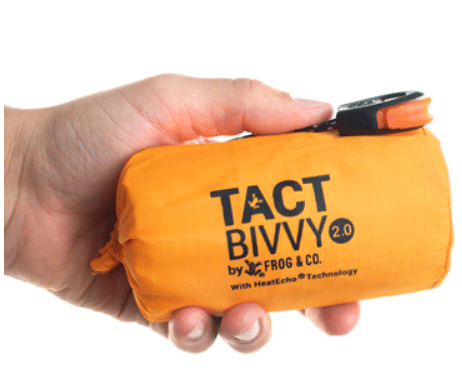
But most often, well, you don’t. Here are some recommendations to heed if you have to sleep in cold weather:
- If you have a radio, listen to weather reports before you go to sleep
- Use insulation layers to make the floor of your shelter warmer to your feet.
- Cover all your skin with insulation
- Stay hydrated and eat enough before you go to bed, if possible.
- If you have warm water, pour it into a bottle and keep it close to your body while sleeping.
- Put off and dry your wet boots to make your feet warmer.
- Use fire-heated rocks to avoid frostbite in your sleep.
15. How to Survive an Avalanche
Your situation can worsen dramatically if you have to face an avalanche. Not every person can get away with it, especially unprepared. One of the most effective ways to survive an Avalanche is closely following the recommendations we give below:
- If you notice an avalanche, immediately get off its way.
- If the snow-flow carries you, lose your gear to lighten up your body.
- Apply swimming movements to keep atop of the avalanche
- Close to the top of an avalanche, create a pocket of air in front of you with your hand, and push another one to the surface of the avalanche. Do it while you can move.
- When buried, your luck is in other people rescuing you.
- If you can get out, do it as fast as you can
16. Getting Rescued
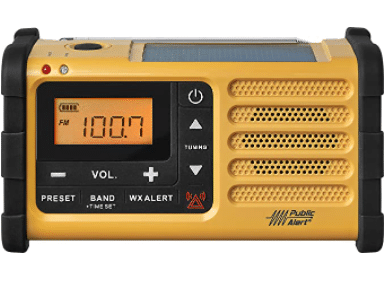
Whether you decide to stay in one place or venture out on your own, you can use these guidelines to help you survive in cold weather situations and beat extreme cold.
Give Signals
The best thing you can do is to make a fire. If you have flairs in your kit, use them reasonably. You can also make a sign by putting branches together in the form of a letter to be visible from above.
You can also stomp some letters on the snow with your feet. History knows examples of successful snow stomping.
Bright colors of your wear will be visible from a distance, so make sure to take them when you pack up before traveling to distant places in conditions of weather extremities.



